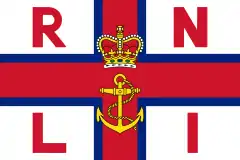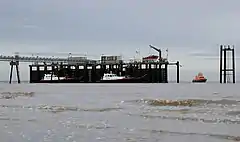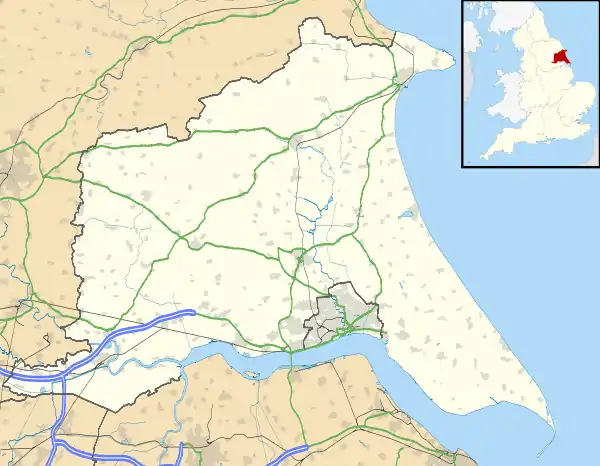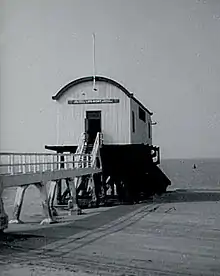Humber Lifeboat Station
The Humber Lifeboat Station is located on Spurn Point in the East Riding of Yorkshire, England. The station is one of nine Royal National Lifeboat Institution (RNLI) lifeboat stations situated along the Yorkshire Coast and the most southerly of them all.[1] It is the only lifeboat station in the United Kingdom that is staffed full-time by a professional RNLI crew; this is due to the waters around this part of the coast being so dangerous and the station's remoteness from the mainland.
| Humber Lifeboat Station Spurn Life Boat Station | |
|---|---|
 | |
 Humber Lifeboat, Spurn Point | |
 Location within the East Riding of Yorkshire | |
| General information | |
| Type | RNLI Lifeboat Station |
| Location | Spurn Point, East Riding of Yorkshire |
| Country | England |
| Coordinates | 53.5763°N 0.1114°E |
| Opened | 1810 |
| Owner | Royal National Lifeboat Institution |
| Website | |
| Official website | |
A lifeboat station has been located on Spurn Point since 1810, the crews have been awarded 33 RNLI medals for gallantry. The current lifeboat is the Pride of the Humber, a Severn-class Lifeboat.[2]
History
A lifeboat station was established in 1810 at Spurn Point with a crew supplied by Hull Trinity House.[3] A decommissioned gun battery emplacement, last used in 1809, was requisitioned as the main lifeboat building and was also partly converted into the Life Boat House Hotel. The crew of the lifeboat were billeted in Kilnsea, 3 miles (5 km) up the coast,[4] until 1819 when cottages were built adjacent to the life boat house.[5] The lifeboat House Hotel was owned and operated by the master of the crew. Apart from selling drink and provisions, the master made a side income from loading gravel and sand onto passing ships.[6] The land and money to fund the operation had been supplied by the local lord of the manor. He petitioned Trinity House to take up the offer of the land and supply a lifeboat to use at Spurn. This they did, engaging Henry Greathead of South Shields in building a ship with ten oars.[7]
In the early days of the rescue boat, the mood of the crew at Spurn was sullen as they were not paid too well and were at the mercy of the master who ran the inn to provide what food and drink they needed. Locals from up the coast would come to load ships with gravel and sand, which they did brandishing revolvers, threatening the crew members, who viewed the enterprise as taking away their self-sufficiency. In 1811, the master wrote to Trinity House to complain about this "Law of the Dunes" as he labelled it, to which they had no legal recourse, with as the nearest officials miles away.[8]
In December 1823, a fierce storm worked the ropes loose on the lifeboat and it capsized. It was ruined and needed replacing.[9] Something similar occurred 60 years later in 1883, again after a particularly stormy night, the crew discovered that their lifeboat had been loosed of its moorings during the storm. This time it was safe and was later found drifting off the island of Texel, off the coast of the Netherlands.[10]
Between 1908 and 1911, the station came under the aegis of the Humber Conservancy Board,[11] who argued that the lifeboat station and crew should be handed over to the RNLI. For their part, the RNLI were reluctant to take on the crew as they were paid, which went against its policy of having volunteers.[12] Eventually, these issues were sorted out and the RNLI assumed control in 1911.[13] In 1919, the first motorised boat, the Samuel Oakes was launched and in 1924, the station name was changed from Spurn Lifeboat to Humber Lifeboat.[14]

The lifeboatmen were known to have taken advantage of the military railway between Spurn Point and Kilnsea as a means of quick transport up the coast to the village. They adapted a boat powered by wind to run along the line. When they met a military supply train travelling in the opposite direction, they were required to remove their sail wagon from the rails to allow the train to pass,[15] not an easy task as the sail wagon had no working brake.[16]
Due to the remoteness of the station, its restricted access (by road from the north) and the dangerous waters around this part of the east coast, the crew are on-site full time and are the only full-time paid RNLI crew in the United Kingdom.[17] Up until 2012, the families of the crew lived in cottages on Spurn Head adjacent to the lifeboat station, but a decision was taken to have two crews revolving through a roster and so the families moved to new accommodation in Kilnsea.[18] As the spit of land is prone to breaches, this was also viewed as in the best interests of the families of the crew members.[19] Latterly, the families had been housed in cottages built in 1975 to replace the row of houses first built in 1819. These were demolished when the seven new houses were built at a cost of £100,000.[20] The retaining wall built to hold the sea back from the domestic area still survives fulfilling its intended purpose.[21] From August 2012 onwards, the two crews rotate through a shift of six days on and six days off.[22]
The lifeboat is moored at the end of a pier that sets out into the Humber Estuary (westwards from Spurn Head) rather than a traditional launch down a ramp into the sea (which is on the eastern side of Spurn Head). This location has been described as being in the lee of bad weather, thereby providing a safer place to set off from.[23] The crew have pushbikes to cycle down to the end of the pier and then use a boarding boat to get to the lifeboat.[24] Despite some buildings being erected to launch the lifeboat, even from the early days, it was recognised of the difficulties in launching the boat from land, so it has been traditionally moored away from the coastline.[25] A traditional lifeboat house with slipway was built in 1923 and used up until 1977, but it fell into disuse with bigger ships arriving that were better moored afloat. The slipway and lifeboat house were demolished in 1995.[9]
The Humber Lifeboat has an operational area that covers the River Humber to Immingham Dock, south along the coastline to Skegness, northwards to Bridlington and up to a 100 miles (160 km) out to sea. This overlaps with the Cleethorpes Lifeboat to the south and the Withernsea Lifeboat to the north and to other rescue agencies along the river.[26] The Bridlington and Skegness lifeboats are the next nearest all-weather lifeboats along the east coast.[27][note 1][28]
Notable rescues

During the stations 200 year plus history, 33 RNLI gallantry medals have been awarded to the crews for their gallantry,[29] including three gold, 13 silver and 17 bronze. Of these, Robert Cross, Coxswain for 31 years until 1943, won two gold, three silver and two bronze, as well as the George Medal.[30]
Exact records of the first 100 years of rescues are patchy, but between 1810 and 1854, over 800 people had been rescued from the seas around Spurn Head.[14] Between 1911 (when the Humber Lifeboat came under RNLI control) and December 2009, the lifeboat was launched 2,268 times saving over 790 lives in the process.[31] At least three crew of the lifeboat were lost at sea during rescues in the 19th century.[32]
- 31 October 1850 - the brig Cumberland was wrecked off the east coast at Kilnsea during a gale. The captain of the Cumberland had already been drowned by the time the Spurn lifeboat arrived and the crew of eight were forced to climb into the rigging to survive. Four were rescued, but the next day the rescue of the other four necessitated the use of rocket lines. One of the Spurn Lifeboatmen, John Branton also was lost at sea.[33]
- 19 November 1855 - the lifeboat capsized whilst assisting the schooner Zabuia Deverell; two of the crew drowned.[34]
- 14 February 1979 - the coaster Revi, a Panamanian registered vessel carrying silver sand, sent out a distress call when she was 30 nautical miles (56 km; 35 mi) off Spurn Point. The ship was foundering in a force ten gale and due to the huge waves at sea, (between 33 feet (10 m) and 39 feet (12 m) high) swamping the ship, she was taking on water. The crew of the City of Bradford IV put to sea at 0:15 am and after several attempts in extremely rough seas, all four crew jumped from the foundering ship onto the lifeboat, with the last person to jump being the master, who was clinging to the side of the ship as she listing 45 degrees to port. The lifeboat headed back to the safety of the Humber Estuary at 2:33 am.[35]
- 17 September 1989 - the crew responded to a distress call after a merchant vessel, the Fiona, stated she had been in a collision with another ship some 10 nautical miles (19 km; 12 mi) east of Spurn Point. The lifeboat Kenneth Thelwall was launched at 5:00 am and when she was 5 nautical miles (9.3 km; 5.8 mi) out from the site of the Fiona, they could see the fire on the other ship involved, the Phillips Oklahoma. 16 of the 25 crew were taken off the now heavily unstable Phillips Oklahoma onto the Humber lifeboat. The coxswain of the lifeboat, Brain Bevan, later described the fire as "The worst I have ever seen at sea."[36]
- 14 August 1990 - Two Royal Air Force Tornado GR.1 aircraft (ZA464 and ZA545) collided 10 nautical miles (19 km; 12 mi) north-east of Spurn Point. The aircrew of one aircraft from RAF Laarbruch (ZA464) ejected, but only the pilot was recovered alive. The aircrew of the other aircraft were deemed to be dead after a search by the Humber lifeboat and other agencies, resulted in no-one being found.[37][38]
Fleet
| Dates in service | Class | ON[lower-alpha 1] | Op. No.[lower-alpha 2] | Name | Comments |
|---|---|---|---|---|---|
| 1901–1902 | Manchester Unity | On loan to Spurn from the RNLI when the Spurn boat was away on repair.[39] | |||
| 1913–1918 | 516 | Charles Deere James | [39] | ||
| 1914–1929 | City of Bradford | Paid for by a fundraising effort in the City of Bradford.[note 2][40][41] | |||
| 1919–1923 | Watson-class | 651 | Samuel Oakes | ||
| 1929–1954 | 45ft 6in Watson-class | 709 | City of Bradford II | She was named at Bridlington to allow people to witness the event and reach the ceremony easily; it was decided that Spurn Point was too remote.[42][43] | |
| 1954–1977 | 46ft 9in Watson-class | 911 | City of Bradford III | Transferred to Lytham St Annes Lifeboat station in 1977[42][44] | |
| 1977–1987 | Arun-class | 1052 | 54-07 | City of Bradford IV | Funded by the Lord Mayor of Bradford's Charity Appeal 1974–1975.[45] |
| 1987–1997 | Arun-class | 1123 | 52-37 | Kenneth Thelwall | Named after its benefactor, Kenneth Thelwall from the East Riding of Yorkshire. Transferred to Holyhead Lifeboat Station.[46][47] |
| 1997– | Severn-class | 1216 | 17-05 | Pride of the Humber |
- ON is the RNLI's Official Number of the boat.
- Op. No. is the RNLI's Operational Number of the boat carried on the hull.
Notes
- The main differences between an all-weather lifeboat and the inshore lifeboats are that the inshore lifeboats operate in shallower water near rocks, cliffs and caves. All-weather lifeboats will self-right in case of capsize, are inherently faster on the water and are fitted with communication and navigational equipment.
- The City of Bradford has paid for several lifeboats (stationed at Teesmouth and Ramsgate as well as at Spurn Head) after a ship carrying wool was wrecked off the Welsh coast in the 19th century with the loss of many lives. Bradford was a prime woollen and worsted town (later city).
References
- "Last goodbye for head of Yorkshire's most remote lifeboat station". The Yorkshire Post. 25 August 2018. Retrieved 8 March 2019.
- "Humber's lifeboat". rnli.org. Retrieved 8 March 2019.
- Sheahan, James Joseph (1864). General and concise history and description of the town and port of Kingston-upon-Hull. London: Simpkin, Marshall & Co. pp. 154–155. OCLC 5824603.
- "292" (Map). Withernsea & Spurn Head. 1:25,000. Explorer. Ordnance Survey. 2015. ISBN 9780319244890.
- Historic England. "Monument No. 1524216". PastScape. Retrieved 4 February 2019.
- Chrystal, Paul (2017). The Place Names of Yorkshire; Cities, Towns, Villages, Rivers and Dales, some Pubs too, in Praise of Yorkshire Ales (1 ed.). Catrine: Stenlake. p. 133. ISBN 9781840337532.
- Blass 2015, p. 90.
- Blass 2015, p. 91.
- Leach 2018, p. 141.
- Chrystal, Paul (2017). The Place Names of Yorkshire; Cities, Towns, Villages, Rivers and Dales, some Pubs too, in Praise of Yorkshire Ales (1 ed.). Catrine: Stenlake. p. 76. ISBN 9781840337532.
- "The Trinity House | British History Online". www.british-history.ac.uk. Retrieved 4 February 2019.
- Astin, Robert (31 May 2017). "Hull History Centre: Spurn Lifeboat Station 1908-1911: Three turbulent years". hullhistorycentre.blogspot.com. Retrieved 6 February 2019.
- "Lifeboats mark 200th anniversary". BBC News. 25 April 2010. Retrieved 4 February 2019.
- Peach, Howard (2001). Curious tales of old East Yorkshire. Wilmslow: Sigma Leisure. p. 148. ISBN 1850587493.
- Collyer, Peter (2002). Rain later, good: painting the shipping forecast (2 ed.). London: Bloomsbury. p. 59. ISBN 978-1-4081-7857-7.
- Historic England. "Spurn Point Military Railway (931916)". PastScape. Retrieved 6 February 2019.
- Simon, Jos (2015). The rough guide to Yorkshire (2 ed.). London: Rough Guides. p. 301. ISBN 9781409371045.
- "Lifeboat families to move inland". BBC News. 22 June 2012. Retrieved 4 February 2019.
- Blass 2015, p. 98.
- Howarth, Patrick, ed. (Summer 1975). "Donate a house?". The Lifeboat. Poole: RNLI. 44 (452): 31. ISSN 0024-3086.
- "Rapid Coastal Zone Assessment Survey; Yorkshire and Lincolnshire, Bempton to Donna Nook" (PDF). historicengland.co.uk. English Heritage. p. 180. Retrieved 13 February 2019.
- Chrystal 2012, p. 84.
- Mitchell, Barry (1985). Ro-ro to Finland. Bridlington: Hutton Press. p. 37. ISBN 9780907033325.
- "In Pictures: Life on Spurn". BBC News. 27 October 2009. Retrieved 4 February 2019.
- Parker, Malcolm; Hughes, Reg (1984). The City of York, Yorkshire Wolds, & East coast. Discovery Guides. p. 23. ISBN 0-86309-020-6.
- Longhorn, Danny (13 October 2010). "Life still precious to us after 200 years: Behind the headlines Danny Longhorn looks at the 200-year history of the Humber Lifeboat service and its courageous crews". Hull Daily Mail. ProQuest 757775840.
- "Family life at point of no return". The Yorkshire Post. 22 March 2008. ProQuest 335456585.
- "Our Lifeboat Fleet and the Types of Lifeboats at the RNLI". rnli.org. Retrieved 6 February 2019.
- Wood, Alexandra (25 August 2018). "Last goodbye for head of Yorkshire's most remote lifeboat station". The Yorkshire Post. Retrieved 4 February 2019.
- "Humber Lifeboat: station history". RNLI. Retrieved 10 January 2021.
- Leach, Nicholas (2013). Lifeboats of the Humber: two centuries of gallantry (2 ed.). Stroud: Amberley. p. iv. ISBN 978-1-848688759.
- "Nostalgia on Tuesday: Point of interest". The Yorkshire Post. 20 November 2018. Retrieved 4 February 2019.
- "Wreck of the Brig Cumberland off Kilnsea". Hull Packet and East Riding Times (3, 435). Column E. 1 November 1850. p. 6. OCLC 271568119.
- "Nostalgia on Tuesday: Point of interest". The Yorkshire Post. 20 November 2018. Retrieved 5 March 2019.
- "WRECKSITE - REVI CARGO SHIP 1967-1979". www.wrecksite.eu. Retrieved 6 February 2019.
- Floyd, Mike, ed. (Autumn 1977). "Sixteen seaman taken off blazing oil tanker". The Lifeboat. Poole: RNLI. 51 (510): 189. ISSN 0024-3086.
- "MAAS Aircraft Accident to Royal Air Force Tornado ZA545 and ZA464" (PDF). webarchive.nationalarchives.gov.uk. Archived from the original (PDF) on 9 November 2012. Retrieved 6 February 2019.
- Napier, Michael (2017). Tornado GR1: an operational history. Barnsley: Pen & Sword. pp. 2377ndash, 239. ISBN 978-1-47387-302-5.
- Chrystal 2012, p. 86.
- Rush, James (10 June 2009). "Lifeboat help sails to 150 years". Bradford Telegraph and Argus. Retrieved 6 February 2019.
- "Can you help the lifeboat fundraisers?". Bradford Telegraph and Argus. 7 February 2007. Retrieved 6 February 2019.
- Longhorn, Daniel (5 January 2010). "Two centuries of Spurn's life-savers: E RIDING: Unique RNLI crew celebrates 200th anniversary". Hull Daily Mail. ProQuest 333691762.
- Leach 2018, p. 5.
- "Name City of Bradford III | National Historic Ships". www.nationalhistoricships.org.uk. Retrieved 5 February 2019.
- Davies, Joan, ed. (Autumn 1977). "North East South East: the Naming of Humber Lifeboat September 10 and Newhaven Lifeboat September 18". The Lifeboat. Poole: RNLI. 45 (462): 90. ISSN 0024-3086.
- Chrystal 2012, p. 88.
- "Family's second lifeboat legacy". BBC News. 9 December 2003. Retrieved 5 March 2019.
Sources
- Blass, Tom (2015). The Naked Shore of the North Sea. London: Bloomsbury. ISBN 978-1-4088-1549-6.
- Chrystal, Paul (2012). Lifeboat Stations of North East England; From Sunderland to The Humber, Through Time. Stroud: Amberley. ISBN 978-1-4456-1376-5.
- Leach, Nicholas (2018). The Lifeboat Service in England; the North East Coast, Station by Station. Stroud: Amberley. ISBN 978-1-4456-6832-1.
External links
| Wikimedia Commons has media related to Humber Lifeboat Station. |
